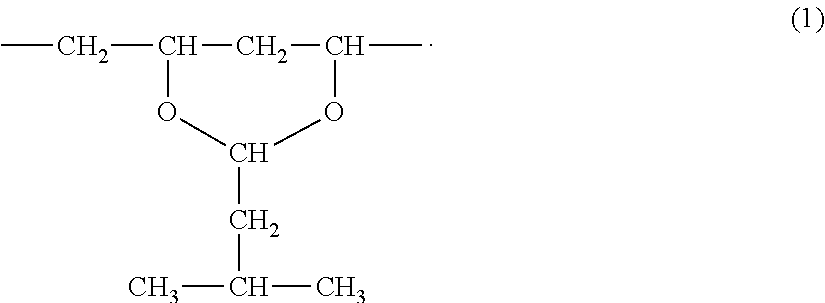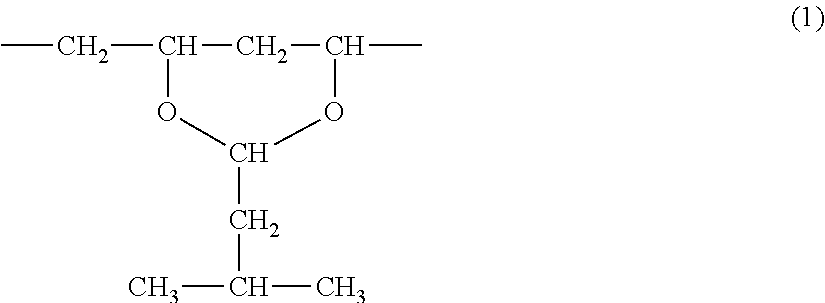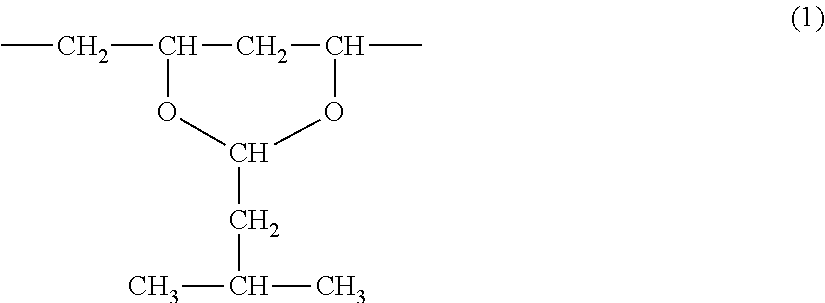Polyvinyl acetal resin, slurry composition prepared therefrom, ceramic green sheet, and multilayer ceramic capacitor
a technology of polyvinyl acetal resin and slurry composition, which is applied in the direction of stacked capacitors, fixed capacitor details, coatings, etc., can solve the problems of easy seat attack phenomenon, poor dispersion of ceramic powder itself, and difficult coating, etc., and achieve small dimensional change in storage and sufficient mechanical strength
- Summary
- Abstract
- Description
- Claims
- Application Information
AI Technical Summary
Benefits of technology
Problems solved by technology
Method used
Image
Examples
example 1
Preparation of Polyvinyl Acetal Resin
[0083]Into a glass container with an inner volume of 2 L provided with a reflux condenser, a thermometer, and an anchor-type impeller, 1295 g of ion exchanged water, and 105 g of polyvinyl alcohol (PVA-1: polymerization degree 1700, saponification degree 99.0 mol %) were charged, the whole was heated to 95° C. to thoroughly dissolve the polyvinyl alcohol, and thus a polyvinyl alcohol aqueous solution (concentration 7.5 mass %) was prepared. The prepared polyvinyl alcohol aqueous solution was cooled to 13° C. over around 30 minutes while stirring at a rotation rate of 120 rpm, and then the resultant aqueous solution was added with 70.5 g of 3-methylbutanal, and further added with 100 mL of hydrochloric acid with a concentration of 20 mass % as an acid catalyst that is an acetalization catalyst, and the acetalization of polyvinyl alcohol was started. After performing the acetalization for 15 minutes, the whole of the resultant mixture was heated to...
example 2
[0085]By using polyvinyl alcohol (PVA-2: polymerization degree 800, saponification degree 99.0 mol %) instead of PVA-1, a polyvinyl acetal resin (PVIV-2) was obtained in the same manner as in Example 1 except that 73.5 g of 3-methylbutanal was used. The content percentage of the vinyl alcohol unit acetalized with 3-methylbutanal was 71.2 mol % (the degree of acetalization was 71.2 mol %), the content percentage of the vinylester unit was 1.0 mol %, and the content percentage of the vinyl alcohol unit was 27.8 mol %. Next, a slurry composition was obtained by using PVIV-2 in the same manner as in Example 1.
example 3
[0086]By using polyvinyl alcohol (PVA-3: polymerization degree 2400, saponification degree 99.0 mol %) instead of PVA-1, a polyvinyl acetal resin (PVIV-3) was obtained in the same manner as in Example 1 except that 70.5 g of 3-methylbutanal was used. The content percentage of the vinyl alcohol unit acetalized with 3-methylbutanal was 68.4 mol % (the degree of acetalization was 68.4 mol %), the content percentage of the vinylester unit was 1.0 mol %, and the content percentage of the vinyl alcohol unit was 30.6 mol %. Next, a slurry composition was obtained by using PVIV-3 in the same manner as in Example 1.
PUM
| Property | Measurement | Unit |
|---|---|---|
| particle diameter | aaaaa | aaaaa |
| particle diameter | aaaaa | aaaaa |
| degree of polymerization | aaaaa | aaaaa |
Abstract
Description
Claims
Application Information
 Login to View More
Login to View More - R&D
- Intellectual Property
- Life Sciences
- Materials
- Tech Scout
- Unparalleled Data Quality
- Higher Quality Content
- 60% Fewer Hallucinations
Browse by: Latest US Patents, China's latest patents, Technical Efficacy Thesaurus, Application Domain, Technology Topic, Popular Technical Reports.
© 2025 PatSnap. All rights reserved.Legal|Privacy policy|Modern Slavery Act Transparency Statement|Sitemap|About US| Contact US: help@patsnap.com



